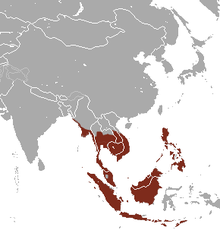| Crab-eating macaque | |
|---|---|

| |
| Scientific classification | |
| Domain: | Eukaryota |
| Kingdom: | Animalia |
| Phylum: | Chordata |
| Class: | Mammalia |
| Order: | Primates |
| Suborder: | Haplorhini |
| Infraorder: | Simiiformes |
| Family: | Cercopithecidae |
| Genus: | Macaca |
| Species: | M. fascicularis
|
| Binomial name | |
| Macaca fascicularis Raffles, 1821
| |

| |
| Crab-eating macaque range | |
| Synonyms[2] | |
| |
The crab-eating macaque (Macaca fascicularis), also known as the long-tailed macaque or cynomolgus macaque, is a cercopithecine primate native to Southeast Asia. As a synanthropic species, the crab-eating macaque thrives near human settlements and in secondary forest. Crab-eating macaques are plastic in their attributes and roles ranging from smart and adaptive, to sacred, to vermin and pest to resource in biomedical research. They have been described as a species on the edge, living on the edge of forests, rivers, and seas, at the edge of human settlements, and maybe on the edge of population decline.
Crab-eating macaques are omnivorous and frugivorous. They live in matrilineal groups ranging from 10 to 85 individuals, with groups exhibiting female philopatry and males emigrating from natal group at puberty. Crab eating macaques are the only old-world monkey known to use stone tools in their daily foraging and they engage in a robbing and bartering behavior in some tourist locations.
The crab-eating macaque is the most traded primate species, the most culled primate species, the most persecuted primate species and also the most popular species used in scientific research. Due to these threats, the crab-eating macaque was listed as Endangered on the IUCN Red List in 2022.
- ^ Hansen, M.F.; Ang, A.; Trinh, T.; Sy, E.; Paramasiwam, S.; Ahmed, T.; Dimalibot, J.; Jones-Engel, L.; Ruppert, N.; Griffioen, C.; Lwin, N.; Phiapalath, P.; Gray, R.; Kite, S.; Doak, N.; Nijman, V.; Fuentes, A. & Gumert, M.D. (2022) [amended version of 2022 assessment]. "Macaca fascicularis". IUCN Red List of Threatened Species. 2022: e.T12551A221666136. doi:10.2305/IUCN.UK.2022-2.RLTS.T12551A221666136.en.
- ^ Fooden, J. (1995). Systematic review of Southeast Asian Longtail Macaques Macaca fascicularis (Raffles [1821]). Fieldiana New Series No. 81. Chicago: Field Museum of Natural History. doi:10.5962/bhl.title.3456.
